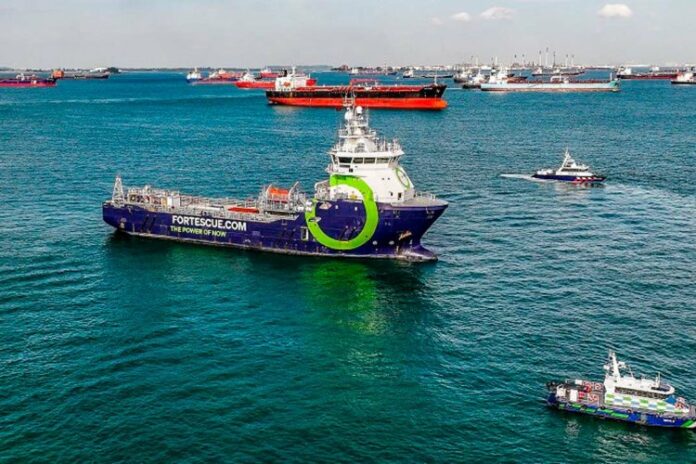Fortescue, with the support from the Maritime and Port Authority of Singapore (MPA) government agencies, research institutes, and industry partners, has successfully conducted the world’s first use of ammonia, in combination with diesel in the combustion process, as a marine fuel onboard the Singapore-flagged ammonia-powered vessel, the Fortescue Green Pioneer, in the Port of Singapore.
The Fortescue Green Pioneer was loaded with liquid ammonia from the existing ammonia facility at Vopak Banyan Terminal on Jurong Island for the fuel trial.
In completing the fuel trial, the Fortescue Green Pioneer has also received flag approval from the Singapore Registry of Ships (SRS) and the “Gas Fuelled Ammonia” notation by classification society DNV to use ammonia, in combination with diesel, as a marine fuel.
The Fortescue Green Pioneer started its journey towards becoming the world’s first ocean-going ammonia-powered vessel in 2022 when Fortescue successfully converted a four-stroke engine to run on ammonia, in combination with diesel, at its land-based testing facility in Perth, Western Australia.
Following the success of the land-based testing, conversion work commenced on the vessel at Seatrium’s Benoi yard from July 2023. This included the installation of the gas fuel delivery system, safety systems and infrastructure, and the successful conversion of two of the vessel’s four engines to enable the use of ammonia, combined with diesel in the combustion process, to power the vessel. The two remaining engines onboard the Fortescue Green Pioneer will operate on conventional fuels when required.
An ammonia plume model was jointly developed by the Agency for Science, Technology and Research’s Institute of High Performance Computing (A*STAR’s IHPC), Nanyang Technological University’s Maritime Energy and Sustainable Development Centre of Excellence (MESD), the Technology Centre for Offshore and Marine, Singapore (TCOMS), and the National University of Singapore’s Tropical Marine Science Institute (TMSI) to determine the safety envelope, model the dispersion of an ammonia plume in an event of an incident, and to support the safety and incident response planning. The model, which accounted for the Fortescue Green Pioneer’s vessel and engine design parameters, behaviour of ammonia within Singapore’s tropical climate, sea current conditions, and surrounding vessels, infrastructure, and geometries, was used to guide the operations. It will be continually enhanced as operations for new maritime fuels scale up in the Port of Singapore.
The fuel trial was conducted over a period of seven weeks and included rigorous testing of the Fortescue Green Pioneer’s ammonia storage systems, associated piping, gas fuel delivery system, retrofitted engines, and seaworthiness.
The two four-stroke retrofitted engines served as proxy for the commercialisation of ammonia-fuelled marine engines under development globally. The post-combustion nitrogen oxide (NOx) levels met the local air quality standard, while efforts to reduce the pilot fuel for combustion ignition and nitrous oxide (N2O) emissions post-combustion will continue as more ammonia-fuelled marine engines and ammonia sources with lower greenhouse gas emissions become available.
The five cubic metres (three tonnes) of liquid ammonia used for the fuel trial was supplied by Vopak using its existing infrastructure at the 10,000m3 Vopak Banyan Terminal on Jurong Island. A second tranche of three tonnes of liquid ammonia will be loaded for the Fortescue Green Pioneer to conduct further tests and trials over the next few weeks.
Fortescue engaged DNV to be part of the innovation process from the very early stages of this project. The Fortescue Green Pioneer’s ammonia fuel systems and engine conversion received class approval by DNV based on DNV’s Technology Qualification process to ensure that the new technology and systems fitted onboard, which were not covered under existing regulations, will function within specified limits and acceptable levels of confidence.
Mr Teo Eng Dih, Chief Executive, MPA, said,
“The safe conduct of this fuel trial supports the holistic assessment of the use of ammonia as a marine fuel, and the development of standards and safety procedures. This will inform the crew training, emergency and bunkering procedures which MPA, agencies and the tripartite community are developing in support of making available safe and cost-efficient solutions as MaritimeSG and the international shipping community undergo the energy transition.”



